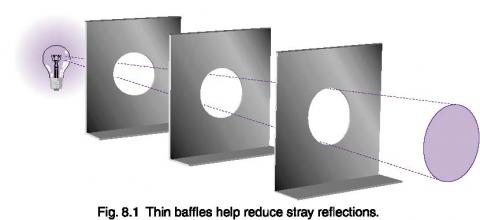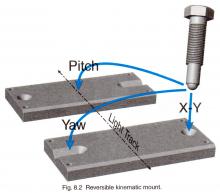Setting Up An Optical Bench (Chapter 8)
A Baffled Light Track
The best light measurement setup controls as many variables as possible. The idea is to prevent the measurement environment from influencing the measurement. Otherwise, the measurement will not be repeatable at a different time and place.
Baffles, for example, greatly reduce the influence of stray light reflections. A baffle is simply a sharp edged hole in a piece of thin sheet metal that has been painted black. Light outside of the optical beam is blocked and absorbed without affecting the optical path.

Multiple baffles are usually required in order to guarantee that light is trapped once it strikes a baffle. The best light trap of all, however, is empty space. It is a good idea to leave as much space between the optical path and walls or ceilings as is practical. Far away objects make weak reflective sources because of the Inverse Square Law. Objects that are near to the detector, however, have a significant effect, and should be painted with “black velvet” paint or moved out of view.
A shutter, door, or light trap in one of the baffles allows you to measure the background scatter component and subtract it from future readings. The “zero” reading should be made with the source ON, to maintain the operating temperature of the lamp as well as measure light that has defeated your baffling scheme.
Kinematic Mounts

Accurate distance measurements and repeatable positioning in the optical path are the most important considerations when setting up an otical bench. The goal of an optical bench is to provide repeatability. It is not enough to merely control the distance to the source, since many sources have non-uniform beams. A proper detector mounting system provides for adjustment of position and angle in 3-D space, as well as interchangeability into a calibrated position in the optical path.
To make a kinematic fixture, cut a cone and a conical slot into a piece of metal using a 45° conical end mill (see fig. 8.2). A kinematic mount is a three point fixture, with the third point being any planar face. The three mounting points can be large bolts that have been machined into a ball on one end, or commercially available 1/4-80 screws with ball bearing tips (from Thorlabs, Inc.) for small fixtures.
The first leg rests in the cone hole, fixing the position of that leg as an X-Y point. The ball tip ensures that it makes reliable, repeatable contact with the cone surface. The second leg sits in the conical slot, fixed only in Yaw, or angle in the horizontal plane.
The use of a slot prevents the Yaw leg from competing with the X-Y leg for control. The third leg rests on any flat horizontal surface, fixing the Pitch, or forward tilt, of the assembly.
A three legged detector carrier sitting on a kinematic mounting plate is the most accurate way to interchange detectors into the optical path, allowing intercomparisons between two or more detectors.

Request Light Management Handbook as PDF (ALL Chapters)
Chapter 8 - The Light Measurement Handbook
Copyright © 1997 by Alexander D. Ryer
All Rights Reserved.
No part of this publication may be reproduced or transmitted in any form or by any means, electronic or mechanical, including photocopying, recording, or any information storage and retrieval system, without permission in writing from the copyright owner. Requests should be made through the publisher.
Technical Publications Dept.
International Light Technologies
10 Technology Drive
Peabody, MA 01960
ISBN 0-9658356-9-3
Library of Congress Catalog Card Number: 97-93677
Explore more light measurement resources
